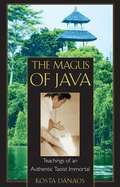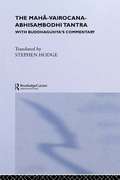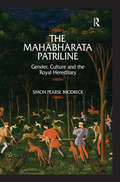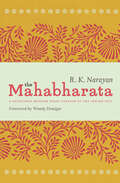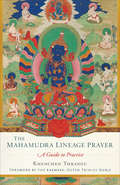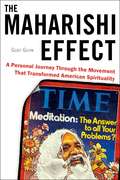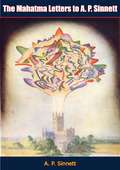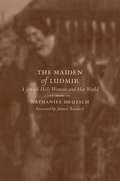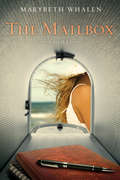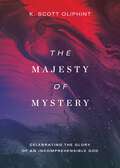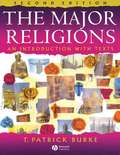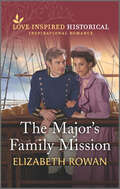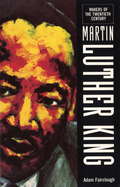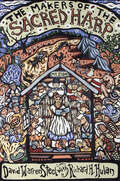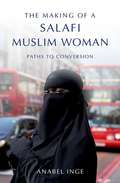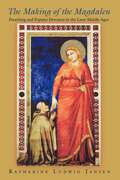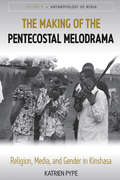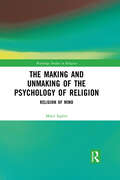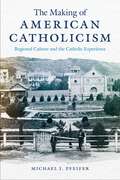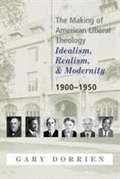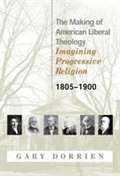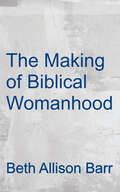- Table View
- List View
The Magus of Java: Teachings of an Authentic Taoist Immortal
by Kosta DanaosThe story of John Chang, the first man to be documented performing pyrokinesis, telekinesis, levitation, telepathy, and other paranormal abilities. • The author, a mechanical engineer, provides scientific explanations of how these powers work. • For the first time, the discipline of Mo-Pai is introduced to the West. In 1988 the documentary Ring of Fire was released to great acclaim. The most startling sequence in the film is that of a Chinese-Javanese acupuncturist who demonstrates his full mastery of the phenomenon of chi, or bio-energy, by generating an electrical current within his body, which he uses first to heal the filmmaker of an eye infection and then to set a newspaper on fire with his hand. Ring of Fire caused thousands to seek out this individual, John Chang, in pursuit of instruction. Of the many Westerners who have approached him, John Chang has accepted five as apprentices. Kosta Danaos is the second of those five. In his years of study with John Chang, Danaos has witnessed and experienced pyrokinesis, telekinesis, levitation, telepathy, and much more exotic phenomena. He has spoken with spirits and learned the secrets of reincarnation. Most important, he has learned John Chang's story. John Chang is the direct heir to the lineage of the sixth-century b.c. sage Mo-Tzu, who was Confucius's greatest rival. His discipline, called the Mo-Pai, is little-known in the West and has never before been the subject of a book. Now, John Chang has decided to bridge the gap between East and West by allowing a book to be published revealing the story of his life, his teachings, and his powers. It will surely expedite what may well become the greatest revolution of the twenty-first century--the verification and study of bio-energy.
The Magus of Strovolos: The Extraordinary World of a Spiritual Healer
by Kyriacos MarkidesIn this vivid account, Kryiacos C Markides introduces to us the rich and intricate world of Daskalso, The Magus of Strovolos. In what appears at first to be an exercise in fantasy, we see Daskalos draw on seemingly unlimited mixture of esoteric teachings, psychology, reincarnation, demonology, cosmology and mysticism, from both eastern and western traditions. But Daskalos is first and foremost a healer, whose work is firmly rooted in a belied in 'Holyspirit' or absolute love, and whose aim is the expansion of reason and spiritual evolution.
The Maha-Vairocana-Abhisambodhi Tantra: With Buddhaguhya's Commentary
by Stephen HodgeThe first complete translation into English of this Tibetan text, together with the informative commentary by the 8th century master Buddhaguhya. This text is of seminal importance for the history of Buddhist Tantra, especially as very little has been published concerning the origins of Tantra in India.
The Mahabharata Patriline: Gender, Culture, and the Royal Hereditary
by Simon Pearse BrodbeckThe Sanskrit Mahabharata (which contains the Bhagavad Gita) is sorely neglected as a classic - perhaps the classic - of world literature, and is of particularly timely human importance in today's globalised and war-torn world. This book is a chronological survey of the Sanskrit Mahabharata's central royal patriline - a family tree that is also a list of kings. Brodbeck explores the importance and implications of patrilineal maintenance within the royal culture depicted by the text, and shows how patrilineal memory comes up against the fact that in every generation a wife must be involved, with the consequent danger that the children might not sustain the memorial tradition of their paternal family. The Mahabharata Patriline bridges a gap in text-critical methodology between the traditional philological approach and more recent trends in gender and literary theory. Studying the Mahabharata as an integral literary unit and as a story stretched over dozens of generations, this book casts particular light on the events of the more recent generations and suggests that the text's internal narrators are members of the family whose story they tell.
The Mahabharata: A Shortened Modern Prose Version of the Indian Epic
by R. K. NarayanThe Mahabharata tells a story of such violence and tragedy that many people in India refuse to keep the full text in their homes, fearing that if they do, they will invite a disastrous fate upon their house. Covering everything from creation to destruction, this ancient poem remains an indelible part of Hindu culture and a landmark in ancient literature. Centuries of listeners and readers have been drawn to The Mahabharata, which began as disparate oral ballads and grew into a sprawling epic. The modern version is famously long, and at more than 1. 8 million words--seven times the combined lengths of the Iliad and Odyssey--it can be incredibly daunting. Contemporary readers have a much more accessible entry point to this important work, thanks to R. K. Narayan's masterful translation and abridgement of the poem. Now with a new foreword by Wendy Doniger, as well as a concise character and place guide and a family tree, The Mahabharata is ready for a new generation of readers. As Wendy Doniger explains in the foreword, "Narayan tells the stories so well because they're all his stories. " He grew up hearing them, internalizing their mythology, which gave him an innate ability to choose the right passages and their best translations. In this elegant translation, Narayan ably distills a tale that is both traditional and constantly changing. He draws from both scholarly analysis and creative interpretation and vividly fuses the spiritual with the secular. Through this balance he has produced a translation that is not only clear, but graceful, one that stands as its own story as much as an adaptation of a larger work.
The Mahabharata: An English Version Based on Selected Verses
by Chakravarthi V. NarasimhanIntended to be a treatise on life itself, this epic poem embraces religion and ethics, polity and government, philosophy and the pursuit of salvation. This collection of more than 4,000 verses is supplemented by a glossary, genealogical tables, and an index correlating the verses with the original Sanskrit text.
The Mahamudra Lineage Prayer: A Guide to Practice
by Khenchen ThranguThe only book in English on a popular Tibetan Buddhist lineage prayer that explains how it can be used as a guide to practice.One of the most beloved and oft-recited prayers in the Kagyu tradition of Tibetan Buddhism, The Mahamudra Lineage Prayer combines a supplication to the Mahamudra lineage with a concise guide to Mahamudra practice and the stages of the path to enlightenment. In this commentary on the prayer, Thrangu Rinpoche teaches in his down-to earth yet direct manner the importance of the Mahamudra lineage, how to develop renunciation and devotion through the common and uncommon preliminary practices, and how to practice calm abiding (Shamatha) and insight (Vipashyana) meditation in the Mahamudra tradition. He explains that Mahamudra teachings are easy to practice yet are very powerful, and are especially appropriate for serious Western Dharma students.
The Maharishi Effect
by Geoff GilpinThis penetrating literary-journalistic memoir depicts the clash between promise and reality within the movement that virtually defined alternative spirituality in America: Transcendental Meditation and its iconic guru, the Maharishi. Like hundreds of thousands of young people, Geoff Gilpin entered the Transcendental Meditation movement in the early seventies, when its guru, the Maharishi Mahesh Yogi, was fresh in the public mind as the spiritual guide to the Beatles and the man who made "meditation" a household word. The movement's Iowa campus was a center of spiritual idealism and healthy living. Gilpin left after five years, settling into a successful career in the software business. Two decades later, wistful over the past and concerned by the increasingly harsh tone of the Maharishi's public pronouncements, Gilpin decided to return and find out what had become of the spiritual community of his youth. His move back to Fairfield, Iowa, proved both revealing and unsettling. He rediscovered what had drawn his generation to Eastern spirituality - and what he and his cohorts had lost in following the usual path to careerism. But he also experienced disturbing changes in a spiritual organization that - while attracting money, celebrity, and clout - had seemingly drifted from its early ideals. Its inner culture, Gilpin observed, had divided into haves and have-nots, in ways both subtle and obvious. The Maharishi - believed to be in his late eighties or early nineties and now living in Holland - was promoting projects that involved global government, third-world rulers, claims of levitation, and grandiose fund-raising campaigns. The Maharishi Effect is one man's bittersweet chronicle of innocence found and lost in the movement that, more than any other, defined spirituality for a generation.
The Mahatma Letters to A. P. Sinnett: To A. P. Sinnett From The Mahatmas M. And K. H.
by A. P. SinnettThe Mahatma Letters to A. P. Sinnett is a foundational work of the Theosophical Movement. First published in 1923 by A. Trevor Barker, this volume gathers most of the letters sent by Mahatmas Morya and Koot Hoomi to A. P. Sinnett and A. O. Hume between the years 1880 and 1884. The original letters are in the British Library.
The Maiden of Ludmir: A Jewish Holy Woman and Her World
by Nathaniel DeutschThe Maiden of Ludmir, a Hasidic holy woman, was born in early nineteenth-century Russia and became famous as the only woman in the three-hundred-year history of Hasidism to function as a rebbe. Nathaniel Deutsch explores her fascinating story for the first time.
The Mailbox
by Marybeth WhalenCentered on a real landmark on the coast of North Carolina, The Mailbox blends intriguing folklore and true faith with raw contemporary issues that affect every woman. When Lindsey Adams first visits the Kindred Spirit mailbox at Sunset Beach, she has no idea that twenty years later she will still be visiting the mailbox--still pouring out her heart in letters that summarize the best and worst parts of her life. Returning to Sunset for her first vacation since her husband left her, Lindsey struggles to put her sorrow into words. Memories surface of her first love, Campbell--and the rejection that followed. When Campbell reappears in her life, Lindsey must decide whether to trust in love again or guard herself from greater pain. The Mailbox is a rich novel about loss, hope, and the beauty of second chances.
The Majesty of Mystery: Celebrating the Glory of an Incomprehensible God
by K. Scott OliphintHow can God be three and one? How can God take on a human nature? If God planned everything, how can I be responsible? Do my prayers make any difference in God's plan? Christians may attempt to "know" God to the best of their ability--leading some to limit God as they contain Him within tidy answers for human understanding. In The Majesty of Mystery, K. Scott Oliphint encourages believers to embrace the mysteries of Christian faith: the Trinity, the incarnation, eternal life, and the balance between God's sovereign will and human choices. Drawing from the Reformed tradition and interacting with the biblical text, Oliphint shows how a profound recognition of our own limitations can lead us into a richer awareness of God's infinite majesty. Written with deep theological knowledge and threaded with everyday implications, The Majesty of Mystery connects the dots between humanity and God, belief and practice, mystery and worship. Oliphint invites readers to rediscover the purpose to which all theology aims--the worship of the incomprehensible God who faithfully reveals himself in Scripture.
The Major Religions: An Introduction with Texts
by T. Patrick BurkeThis popular introduction to the world's major religions provides a comprehensive survey of the major traditions together with selected primary readings. A new edition of this popular introduction to the world's major religions Provides a comprehensive survey of the major religious traditions together with selected primary readings Focuses on the beliefs and values that animate each religion, helping students to understand what makes them meaningful to their followers Includes new material on Sikhism and additional material on each religion's ethics and their encounter with the modern world Features chapter-by-chapter discussion and test questions, summaries, and suggestions for further reading Improved visual design, with extensive student aids including revised maps, timeline and charts. The book is accompanied by a website at http://www. blackwellpublishing. com/burke
The Major's Family Mission
by Elizabeth RowanThey were forced to marry.But will they choose to love? Moving to the wilds of California is just the fresh start Major Benjamin Sheffield hoped for—but first the widower needs a mother for his two little girls. So when feisty New York socialite Moira Blackthorne&’s reckless nature puts her reputation at risk, Ben&’s sure a marriage of convenience can solve both their problems. Setting sail for a new home as the wife of a stranger isn&’t quite the life Moira pictured. But the more she gets to know the dignified major and his adorable daughters, the harder she falls…and begins to wish for more than a marriage in name only.
The Makers Of the 20th Century: Martin Luther King
by Adam FaircloughPart of a series of biographies of statesmen and women who have shaped the modern world, this book concerns Martin Luther King, who from both the pulpit and from jail, inspired black Americans to defy white supremacy and in so doing, re-invigorated American democracy.
The Makers of the Sacred Harp (Music in American Life #31)
by David Warren SteelThis authoritative reference work investigates the roots of the Sacred Harp, the central collection of the deeply influential and long-lived southern tradition of shape-note singing. Where other studies of the Sacred Harp have focused on the sociology of present-day singers and their activities, David Warren Steel and Richard H. Hulan concentrate on the regional culture that produced the Sacred Harp in the nineteenth century and delve deeply into history of its authors and composers. They trace the sources of every tune and text in the Sacred Harp, from the work of B. F. White, E. J. King, and their west Georgia contemporaries who helped compile the original collection in 1844 to the contributions by various composers to the 1936 to 1991 editions. The Makers of the Sacred Harp also includes analyses of the textual influences on the music--including metrical psalmody, English evangelical poets, American frontier preachers, camp meeting hymnody, and revival choruses--and essays placing the Sacred Harp as a product of the antebellum period with roots in religious revivalism. Drawing on census reports, local histories, family Bibles and other records, rich oral interviews with descendants, and Sacred Harp Publishing Company records, this volume reveals new details and insights about the history of this enduring American musical tradition.
The Making Of A Salafi Muslim Woman: Paths To Conversion
by Anabel IngeThis view depicts Salafi women as the hapless victims of a fanatical version of Islam. Yet in Britain, growing numbers of educated women--often converts or from less conservative Muslim backgrounds-are actively choosing to embrace Salafism's literalist beliefs and strict regulations, including heavy veiling, wifely obedience, and seclusion from non-related men.
The Making Of The Magdalen: Preaching And Popular Devotion In The Later Middle Ages
by Katherine Ludwig JansenBest known during the Middle Ages as the prostitute who became a faithful follower of Christ, Mary Magdalen was the most beloved female saint after the Virgin Mary. Why the Magdalen became so popular, what meanings she conveyed, and how her story evolved over the centuries are the focus of this compelling exploration of late medieval religious culture. Analyzing previously unpublished sermons, Katherine Jansen uses the lens of medieval preaching to examine the mendicant friars' transformation of Mary Magdalen, a shadowy gospel figure, into an emblem of action and contemplation, a symbol of vanity and lust, a model of perfect penance, and the embodiment of hope and salvation. She draws on diverse historical sources to reveal the laity's devotion to Mary Magdalen, which departed significantly from the friars' image of the saint, signaling a major development in popular religious practice and personal piety. Finally, the author comprehensively addresses the question of the House of Anjou's alliance with the Magdalen, and illuminates the relationship between politics and sanctity in southern France and Italy. Jansen shows how perceptions of the Magdalen merged with errors and misunderstandings to shape the social, spiritual, and political agendas of the later Middle Ages. She brings to life the rich complexity of medieval culture, which condemned female sexuality and women's preaching and yet popularized the veneration of Mary Magdalen as a former prostitute chosen by Christ to be the "apostle of the apostles," the first to witness and preach the Good News of the Resurrection.
The Making Of The Pentecostal Melodrama
by Katrien PypeHow religion, gender, and urban sociality are expressed in and mediated via television drama in Kinshasa is the focus of this ethnographic study. Influenced by Nigerian films and intimately related to the emergence of a charismatic Christian scene, these teleserials integrate melodrama, conversion narratives, Christian songs, sermons, testimonies, and deliverance rituals to produce commentaries on what it means to be an inhabitant of Kinshasa.
The Making and Unmaking of a Saint
by Mathew KueflerA crusader, a hermit, a bishop, a plague victim, and even a repentant murderer by turns: the stories attached to Saint Gerald of Aurillac offer a strange and fragmented legacy. His two earliest biographies, written in the early tenth and early eleventh centuries, depicted the saint as a warrior who devoted his life to pious service. Soon Gerald was a venerated figure, and the monastery he founded was itself a popular pilgrimage site. Like many other cults, his faded into obscurity over time, although a small group of loyal worshippers periodically revived interest, creating sculpted or stained glass images and the alternate biographies that complicated an ever more obscure history.The Making and Unmaking of a Saint traces the rise and fall of devotion to Gerald of Aurillac through a millennium, from his death in the tenth century to the attempt to reinvigorate his cult in the nineteenth century. Mathew Kuefler makes a strong case for the sophistication of hagiography as a literary genre that can be used to articulate religious doubts and anxieties even as it exalts the saints; and he overturns the received attribution of Gerald's detailed Vita to Odo of Cluny, identifying it instead as the work of the infamous eleventh-century forger Ademar of Chabannes. Through his careful examination, the biographies and iconographies that mark the waxing and waning of Saint Gerald's cult tell an illuminating tale not only of how saints are remembered but also of how they are forgotten.
The Making and Unmaking of the Psychology of Religion: Religion of Mind (Routledge Studies in Religion)
by Matei IagherThis book examines the rise and demise of the psychology of religion in the late 19th and early 20th centuries in Europe and the United States. It considers the formation of the psychology of religion as an international movement, an enterprise whose goal was to refashion the science of religion at the turn of the century. Drawing on published sources and archival accounts, the chapters engage with the work of notable figures including William James, C.G. Jung, and Pierre Janet, placing it alongside lesser-known practitioners such as Ernest Murisier, James Henry Leuba, James Pratt, and George Albert Coe. In addition to probing the intellectual background and professional context for the emergence of this sub-discipline, the book examines the development of key concepts and methodologies among psychologists of religion and offers arguments both for the rise of the discipline as well as for its demise in the early decades of the 20th century.
The Making of American Catholicism: Regional Culture and the Catholic Experience
by Michael J. PfeiferTraces the development of Catholic cultures in the South, the Midwest, the West, and the Northeast, and their contribution to larger patterns of Catholicism in the United StatesMost histories of American Catholicism take a national focus, leading to a homogenization of American Catholicism that misses much of the local complexity that has marked how Catholicism developed differently in different parts of the country. Such histories often treat northeastern Catholicism, such as the Irish Catholicism of Boston, as if it reflects the full history and experience of Catholicism across the United States.The Making of American Catholicism argues that regional and transnational relationships have been central to the development of American Catholicism. The American Catholic experience has diverged significantly among regions; if we do not examine how it has taken shape in local cultures, we miss a lot. Exploring the history of Catholic cultures in New Orleans, Iowa, Wisconsin, Los Angeles, and New York City, the volume assesses the role of region in American Catholic history, carefully exploring the development of American Catholic cultures across the continental United States.Drawing on extensive archival research, The Making of American Catholicism argues that American Catholicism developed as transnational Catholics creatively adapted their devotional and ideological practices in particular American regional contexts. They emphasized notions of republicanism, individualistic capitalism, race, ethnicity, and gender, resulting in a unique form of Catholicism that dominates the United States today. The book offers close attention to race and racism in American Catholicism, including the historical experiences of African American and Latinx Catholics as well as Catholics of European descent.
The Making of American Liberal Theology: Idealism, Realism, and Modernity 1900-1950
by Gary DorrienGary Dorrien explores American theological liberalism in its heyday--at the advent of the research university and the institutionally identified school. <P><P>He argues that in its prime theological liberalism effected a creative blending of theological schools, featured a tension between its evangelical and modernist impulses, and was fueled by its expectation of social and cultural progress, until its optimism was subjected to withering internal criticism in the 1930s.
The Making of American Liberal Theology: Imagining Progressive Religion 1805-1900
by Gary DorrienGary Dorrien mixes theological analysis with historical and biographical detail to present the first comprehensive interpretation of American theological liberalism. Arguing that the indigenous roots of American liberal theology existed before the rise of Darwinism, Dorrien maintains that this tradition took shape in the nineteenth century and was motivated by a desire to map a progressive "third way" between authority-based orthodoxies and atheistic rationalism.
The Making of Biblical Womanhood: How the Subjugation of Women Became Gospel Truth
by Beth Allison BarrBiblical womanhood--the belief that God designed women to be submissive wives, virtuous mothers, and joyful homemakers--pervades North American Christianity. From choices about careers to roles in local churches to relationship dynamics, this belief shapes the everyday lives of evangelical women. Yet biblical womanhood isn't biblical, says Baylor University historian Beth Allison Barr. It arose from a series of clearly definable historical moments.
